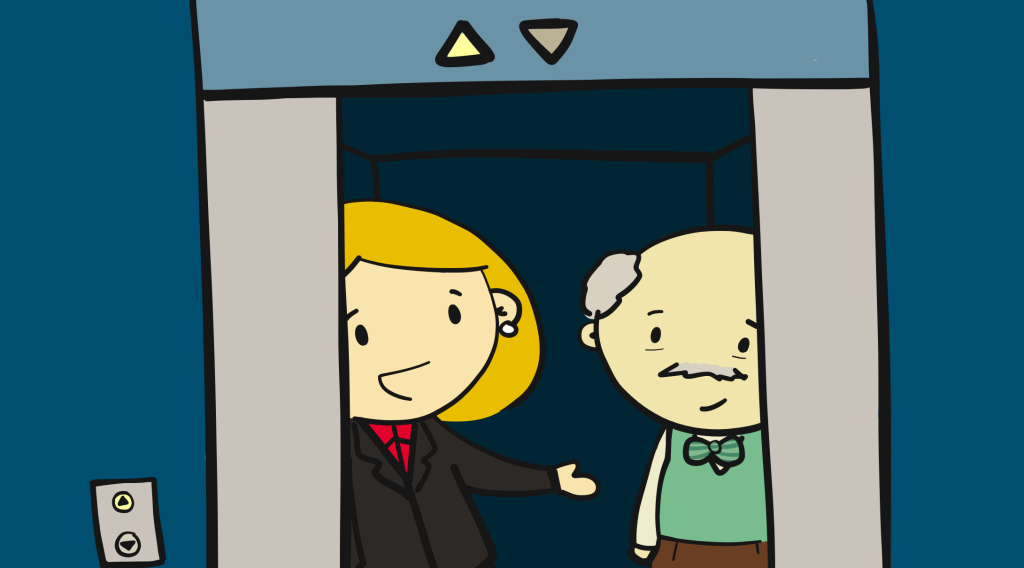Job seekers never know who they might meet that could connect them to their dream position. From the recruiter at a local job fair to the friendly new member of the library book club, every person should be regarded as a potential helper. (Yes, this does mean you should let your grandmother introduce you to her neighbor who she’s sure does something in your field.)
People cannot assist, however, if they don’t have a clue who you are or what you offer. An elevator pitch serves as a starting point. Sharpening yours can be the difference between forming a meaningful connection and letting opportunity slip by.
What is an elevator pitch?
Basically, an elevator pitch is an introduction that serves as a springboard for further conversation. It provides someone with a glimpse about your qualifications and passions. Much of the time, it answers the oft-asked question “What do you do?”
What it is not: A detailed account of your life or a plea to find you a job. Elevator pitches typically don’t last more than 30 seconds, with most experts suggesting 15 seconds or less. As the name implies, think of it as the time you’d have to talk to someone in an elevator.
Creating a memorable pitch
Your audience starts generating a first impression based on what you say, so it pays to be prepared. Here are some tips to get your creative juices flowing:
- Start with self-awareness. Identify your interests, skills, and background. When you’re clear about your desires and what you bring to the table, it’s easier to convey that information and enthusiasm to others.
- Ponder the question “What do I want others to walk away knowing?” Since the speech is so short, its purpose must be evident.
- Use active verbs to paint a vivid picture in the listener’s mind. Words such as “lead,” “teach,” “orchestrate,” and “coordinate” pack a greater punch than simply saying you “work on” something or “did” this and that.
- Write out your pitch. Putting pen to paper allows you to formulate what you want to say. “Winging it” often leads to lengthy rambling that falls on deaf ears.
Tailor to your audience
Like pulling from a closet full of clothes, pick the “right” elevator pitch for the event. Adjustments to your elevator pitch will need to be made based on the professional or social situation. Talking to a fellow tech geek at a conference is much different than striking up a conversation with another parent at your daughter’s soccer game. Pitch to the appropriate level by asking yourself what this particular person might find interesting or helpful. Success comes from sparking the other party to engage in follow-up, not from trying to prove how much you know.
Things to avoid
Few of us are so interesting that we can pull off a lengthy monologue, so don’t try to monopolize someone’s time (think more like a Twitter post than a speech). Also, while you certainly want to be memorable, watch out that you don’t come off as corny. If saying your pitch feels awkward, it probably feels twice as bad for the uncomfortable listener.
And definitely don’t put your new acquaintance on the spot. Saying “Hello, I’m Jane. I’m a whiz at Microsoft Office, and I really need a job because I have three kids. Can you help me get one?” is a sure-fire way to encourage the ambushed suspect to run for the nearest exit.
Practice makes perfect
Great pitches roll off the tongue, so practice yours until it comes out naturally. Something that sounds awesome on paper may actually be cumbersome to say aloud, so revise as necessary.
When you’ve got a pitch you like, try it out. Start by running it by people you already know and trust. They can offer feedback before you take it “live.” Then, use your pitch in actual situations, and see how others react. Adjust as needed for effectiveness.
Finally, remember that a poor delivery can ruin even the most impressive elevator pitch. Speak clearly and confidently. Stand up straight, look your audience in the eye, and smile. Friendly, genuine people make others want to know them better, which is the ultimate goal of an elevator pitch!



